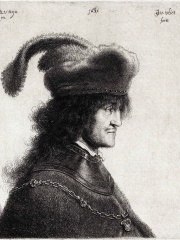
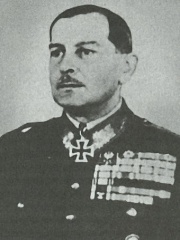
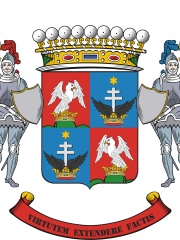
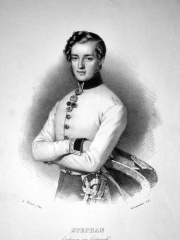
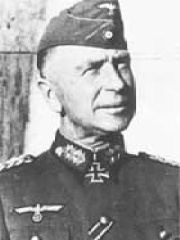
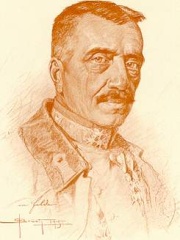

The Most Famous
MILITARY PERSONNELS from Hungary
This page contains a list of the greatest Hungarian Military Personnels. The pantheon dataset contains 2,058 Military Personnels, 8 of which were born in Hungary. This makes Hungary the birth place of the 33rd most number of Military Personnels behind Iraq, and Georgia.
Top 8
The following people are considered by Pantheon to be the most legendary Hungarian Military Personnels of all time. This list of famous Hungarian Military Personnels is sorted by HPI (Historical Popularity Index), a metric that aggregates information on a biography's online popularity.

1. George I Rákóczi (1593 - 1648)
With an HPI of 67.63, George I Rákóczi is the most famous Hungarian Military Personnel. His biography has been translated into 25 different languages on wikipedia.
George I Rákóczi (8 June 1593 – 11 October 1648) was Prince of Transylvania from 1630 until his death in 1648. Prior to that, he was a leader of the Protestant faction in Hungary and a faithful supporter of Gabriel Bethlen, his predecessor as Prince. When Bohemian nobles requested military support in their struggles against the Habsburg monarchy, Rákóczi persuaded Bethlen to help and commanded Transylvanian forces in several battles. Rákóczi was elected prince after Bethlen's death, after short reigns by Bethlen's wife Catherine of Brandenburg (reigned 1629–1630) and brother Stephen Bethlen (reigned September – December 1630). Rákóczi's reign was notable for his involvement in the Thirty Years War, with a 1644–45 campaign against Ferdinand III, Holy Roman Emperor. After Rákóczi held Upper Hungary and most of Lower Hungary at one point, the fighting was ended by the Treaty of Linz, under which seven counties of Upper Hungary – Abaúj, Bereg, Borsod, Szabolcs, Szatmár, Ugocsa and Zemplén were annexed by Transylvania. Five of these were handed back to the Habsburg monarchy after Rákóczi's death with Szabolcs and Szatmár remaining Transylvanian.

2. Gusztáv Jány (1883 - 1947)
With an HPI of 67.13, Gusztáv Jány is the 2nd most famous Hungarian Military Personnel. His biography has been translated into 25 different languages.
Colonel General Vitéz Gusztáv Jány (born Gusztáv Hautzinger; 21 October 1883 – 26 November 1947) was a Hungarian military officer during the Second World War who commanded the Hungarian Second Army at the Battle of Stalingrad. After the war, he was found guilty of war crimes and executed by firing squad. He was posthumously exonerated in 1993 by the Supreme Court of Hungary.

3. Gyula Cseszneky (1914 - 1970)
With an HPI of 65.25, Gyula Cseszneky is the 3rd most famous Hungarian Military Personnel. His biography has been translated into 32 different languages.
Vitéz Count Gyula István Cseszneky de Milvány et Csesznek (Hungarian: vitéz cseszneki és milványi gróf Cseszneky Gyula István; 28 June 1914 – after 1970) was a Hungarian aristocrat, poet, cavalry officer who took part in the Hungarian reannexation of Northern Transylvania, and served as aide-de-camp to King Tomislav II of Croatia. He was also involved in anti-Nazi conspiracies and played an important role in the rescue of the European Jews.

4. Archduke Stephen, Palatine of Hungary (1817 - 1867)
With an HPI of 64.34, Archduke Stephen, Palatine of Hungary is the 4th most famous Hungarian Military Personnel. His biography has been translated into 19 different languages.
Archduke Stephen Francis Victor (German: Stephan Franz Viktor; Hungarian: István Ferenc Viktor; 14 September 1817 – 19 February 1867) was a member of the House of Habsburg-Lorraine and the last Palatine of Hungary, serving from 1847 to 1848.
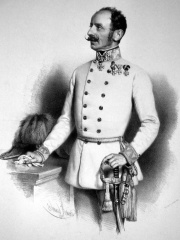
5. Ludwig von Benedek (1804 - 1881)
With an HPI of 64.00, Ludwig von Benedek is the 5th most famous Hungarian Military Personnel. His biography has been translated into 18 different languages.
Ludwig August Ritter von Benedek (14 July 1804 – 27 April 1881), also known as Lajos Benedek, with the Hungarian form of Ludwig, was an Austro-Hungarian general (Feldzeugmeister), best known for commanding the imperial army in 1866 in their defeat at the Battle of Königgrätz against the Prussian Army, which ended his career.

6. Maximilian de Angelis (1889 - 1974)
With an HPI of 61.69, Maximilian de Angelis is the 6th most famous Hungarian Military Personnel. His biography has been translated into 19 different languages.
Maximilian de Angelis (2 October 1889 – 6 December 1974) was a general in the Wehrmacht of Nazi Germany during World War II. He was a recipient of the Knight's Cross of the Iron Cross with Oak Leaves. On 4 April 1946 Angelis was extradited to Yugoslavia and sentenced to 20 years for war crimes. He was then extradited to the Soviet Union and sentenced to two times 25 years. He was released in 1955 and repatriated to Germany.

7. Karl von Pflanzer-Baltin (1855 - 1925)
With an HPI of 58.09, Karl von Pflanzer-Baltin is the 7th most famous Hungarian Military Personnel. His biography has been translated into 16 different languages.
Karl Freiherr von Pflanzer-Baltin (1 June 1855, Pécs, Austrian Empire – 8 April 1925, Vienna) was an Austro-Hungarian general who was active in World War I.

8. András Toma (1925 - 2004)
With an HPI of 56.42, András Toma is the 8th most famous Hungarian Military Personnel. His biography has been translated into 16 different languages.
András Toma (5 December 1925 – 30 March 2004) was a Hungarian soldier taken prisoner by the Red Army in 1944, then discovered living in a Russian psychiatric hospital in 2000. He was most likely the last prisoner of war from the Second World War to be repatriated. Because Toma never learned Russian and nobody at the hospital spoke Hungarian, he had apparently not had a single conversation in over 50 years, a situation of great interest for the fields of psychiatry and psycholinguistics.
People
Pantheon has 8 people classified as Hungarian military personnels born between 1593 and 1925. Of these 8, none of them are still alive today. The most famous deceased Hungarian military personnels include George I Rákóczi, Gusztáv Jány, and Gyula Cseszneky.
Deceased Hungarian Military Personnels
Go to all RankingsGeorge I Rákóczi
1593 - 1648
HPI: 67.63
Gusztáv Jány
1883 - 1947
HPI: 67.13
Gyula Cseszneky
1914 - 1970
HPI: 65.25
Archduke Stephen, Palatine of Hungary
1817 - 1867
HPI: 64.34
Ludwig von Benedek
1804 - 1881
HPI: 64.00
Maximilian de Angelis
1889 - 1974
HPI: 61.69
Karl von Pflanzer-Baltin
1855 - 1925
HPI: 58.09
András Toma
1925 - 2004
HPI: 56.42
Overlapping Lives
Which Military Personnels were alive at the same time? This visualization shows the lifespans of the 7 most globally memorable Military Personnels since 1700.

